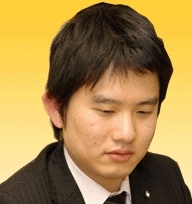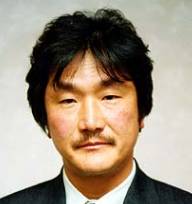Kisei - 2008
Final score: Yamashita Keigo - Cho Chikun 4-3
Quick links to the games: Game 1 | Game 2 | Game 3 | Game 4 | Game 5 | Game 6 | Game 7

I covered last year's Kisei title, when Yamashita defended his title against Kobayashi Satoru.

This year the challenger is Cho Chikun, who defeated Yamashita in the Judan title match last year.
The main referee is Kobayashi Koichi (who, by the way, won the Kisei title from Cho Chikun in 1987, then defended it for the next 7 years against Takemiya Masaki, Kato Masao, Takemiya again, Otake Hideo, Kato again, Yamashiro Hiroshi, and Kato for the 3rd time, before finally losing the title in 1993 to the same person whom he took it the first time, and who is this year's challenger: Cho Chikun).
Videos from the opening ceremony: both players are having a very good time.
Game 1

Game 1 started on January, 12th 2008 in Sao Paulo, Brazil.
The first day of the first game ended peacefully (last move on the board: Black 43), with solid positions for both players. Black can harass a little bit White's upper-left corner, but no major attack looks possible. It was amazing how solid Black's move 41 is: an one point jump from his ogeima shimari. The purpose is clear, though: White is very strong on the left side, and ogeima shimari is open to a 3x3 invasion, so Black wanted to eliminate that threat. Also, Black 41 makes miai en extension on the lower side and an invasion on the right side for Black.
Yamashita sealed the last move of day one. The next two photos show him handing the sealed move envelope to the main referee, Kobayashi Koichi at the end of day one, then placing the sealed move on the board at the beginning of day two while the referee is showing Cho the sealed game record for confirmation.


After going through the variations from the professional commentary at Cyberoro, my understanding was that Cho's fuseki was slack, and White had an easier game after move 50 (6 moves into day 2).
Update: after asking Tei Meiko Sensei it look like it was a close game for quite a long time; Cho Sensei must have missed White's tesuji at 124 which can be blamed on his uneven time usage (he entered in byo-yomi very early, at move 63).
Next photo shows the analysis after the game.

Game 2
Game 2 was played on January 30th and 31st, 2008.
It is interesting that with move 14 Cho is "asking" Yamashita "What about playing the Magic sword of Muramasa Joseki?" Yamashita is up to the challenge and starts the complicated variation with Black 15. This complex joseki is rarely seen in professional games.
Another interesting move of the first day is White's wedge with 36.
White (Cho) got an early lead after he chased the Black group on the right side, then invaded the Black moyo in the upper left, forcing Yamashita to resign in the end.
Game 3
Game 3 was played on February 7th and 8th, 2008.
Game 3 started with a long fight in the lower left corner, while the lower right corner was still empty until move 70! Yamashita forced Cho to resign in the end.
Game 4
Game 4 was played on February 21st and 22nd 2008. Yamashita won by resignation, but it looked like it was a good game for Cho (White) based on the variations shown in the pro comments from Cyberoro.
Here's what looks like Cho's losing move (160 in the lower right corner):

And here's what looks like Cho's last chance: starting a ko in the upper right corner which is not only very large teritorially, but it fixes White's eye shape on the right side (in the game Black played 165 which threatened both White's right side group and White's territory on the lower side and looked like a deadly blow - see the game record below).

Game 5
Game 5 was played on February 26 and 27, 2008. Cho (Black) won by 3.5 points.

One of the most interesting parts of the game was the sacrifice that Cho made on the right side (see the sequence shown in the next 2 diagrams): as a result, he got thickness into the center that translated later into quite large territories on the lower side and in the center.


Game 6
Game 6 was played on March 13th and 14th, 2008. Cho won by 4.5 points and evened the score to 3-3.

The following diagram shows the position after day 1. Yamashita's early attack in the upper right and the resulted thickness in the center didn't pay off in the end, though: Cho's territory prevailed, so the Kisei title this year is going all the way to the 7th game!

We can see next what happened after Yamashita's attack in the upper-right ended (moves 72 to 94): Black took profit on the left side (although the captured White stones still have aji), but White also became very strong in the lower-left. Also, White's kikashi with 72 is put to good use later, when White cuts with 94.

Game 7
Game 7 was played on March 19 and 20, 2008. This was the last game of the series: the Kisei title is a "best of seven" match, and the score before this was 3-3.
Yamashita won the game by resignation and kept the Kisei title.
The following diagram shows the position at the end of day 1. The last move was White 44.

In day 2 the fight in the center continued. The game became most violent in the second half, when Cho tried (unsuccessfully) to turn the tables after Yamashita took territorial advantage around move 136.
